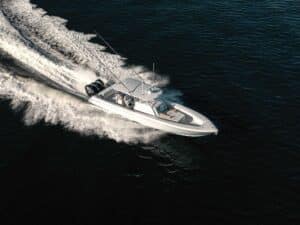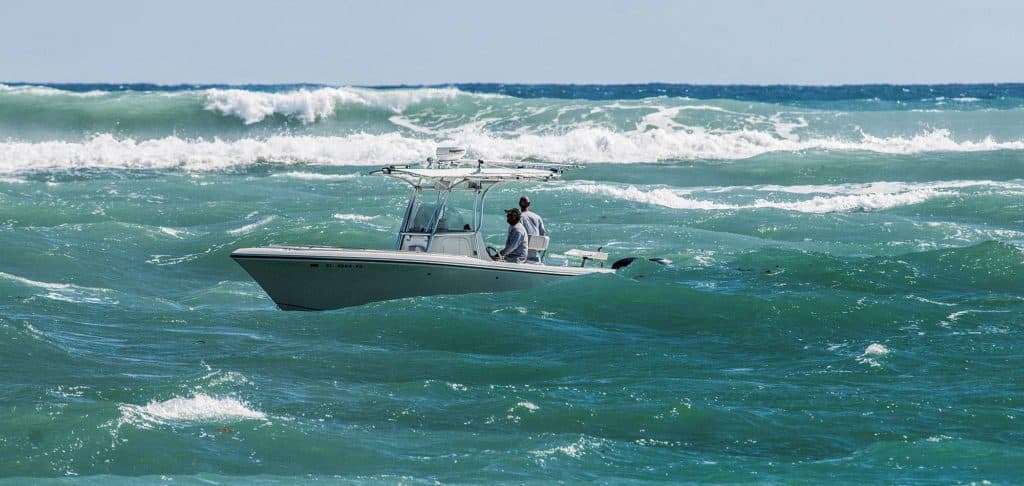
I still remember that unsettling advice delivered 35 years ago from our skipper Ed Pitts as he pointed his 25-foot single-outboard HydraSports center console toward the wave-swept inlet to California’s Oceanside Harbor.
It was my first such experience. A big storm raged hundreds of miles away. We had enjoyed pleasant weather while fishing, but the distant tempest generated an onslaught of combers that began pounding the coast at the same time as our afternoon return.
Lack of recent channel dredging resulted in a bar that thrust the big, long-period swells into steep, mountainous waves. They curled, broke and boomed like thunder at the narrow entrance.
We weren’t alone. A fleet of boats hovered outside the harbor mouth, assessing the situation. But for us, it was worse. A propeller with a worn hub had started to slip on the way home but seemed to regain its precarious grip. For now.
Despite the complication — and after a bit of deliberation — Pitts decided to head in. We donned life jackets, and with his advice still ringing in my ears, I secured a white-knuckle grip on the console grab rail. He eased the throttle ahead and accelerated toward the harbor mouth.
Our timing was bad. Almost immediately, a racing wall of water rose up from astern. It would surely overtake us. Pitts reacted swiftly, bringing the 25-footer about to ascend the face of the swell before it broke. Once on the backside, he quickly spun around and followed the big wave home.
Inside the harbor, bobbing in the froth left by the crashing seas, we heaved a collective sigh of relief. We would live to fish another day.
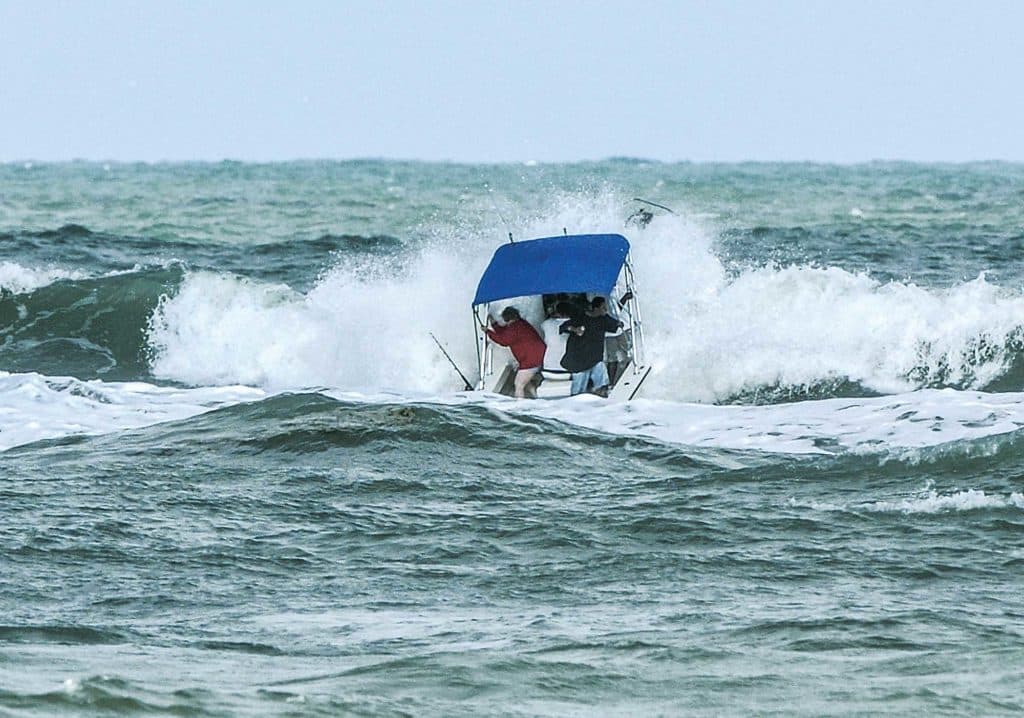
An ironic truth of saltwater fishing holds that some of the roughest water often erupts just as you’re departing from or returning to port. From inlets along the south shore of New York’s Long Island to the Outer Banks of North Carolina and cuts along Florida’s east coast to the harbors of the Pacific Coast, boating anglers face some of the world’s most challenging sea conditions.
It’s not just waves. A combination of factors turns inlets nasty. A powerful outgoing tide streaming through a narrow channel and a strong onshore wind can pile up seas. Combine these two factors with shoaling and shifting channels, and you have waves that are not only steep, but also packed tightly and breaking. In places such as North Carolina’s Oregon Inlet, treacherous water can stretch for a mile or more. Not fun.
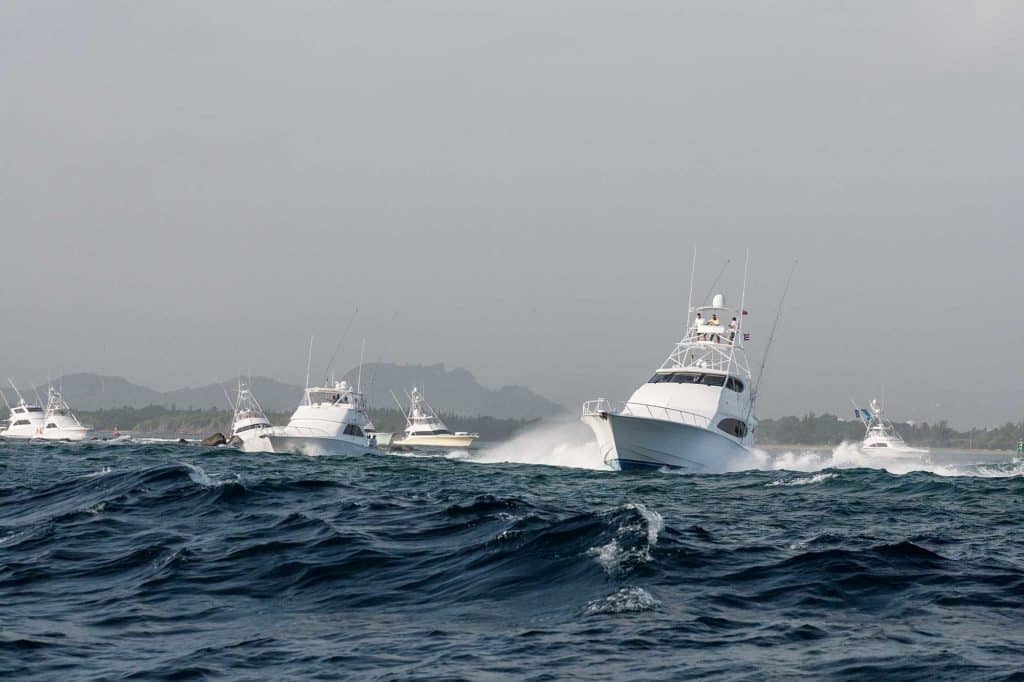
Seek Advice
Before you tackle a dicey inlet, research the conditions, says boating angler Brendan Strum of Manteo, North Carolina, who’s run in and out of Hatteras and Oregon inlets for more than 30 years, chasing bluefin tuna, mahi, marlin, wahoo and other species. While Strum now runs a Regulator 31 with twin Yamaha 300 outboards, much of his experience running inlets came aboard a Regulator 25 with twin Yamaha 200s.
“Talk to other people, especially if you have not been out for a week or more,” Strum implores. “Our inlets change from day to day, so I always call guys I know to get the latest information.”
Expanding your base of fishing friends and sharing information ranks as one of the most important facets of inlet safety. “Never assume you’re an expert, no matter how much experience you have,” advises Strum, who confesses to being nervous every time he crosses the bar at Oregon Inlet. “You need to listen to others who’ve run the inlets in the past day or two.”
Read Next: Six Tips for Fishing Safely Near Breakers
If you are unfamiliar with an inlet, consider hiring a guide with strong knowledge of the inlet to show you the way. Use your chart plotter to record the track. Keep in mind, however, that the safest course can change quickly.
Stay posted on the latest weather conditions and tides, using online resources such as Buoy Weather and NOAA marine weather, checking not only for your departure time, but also for your anticipated return time.
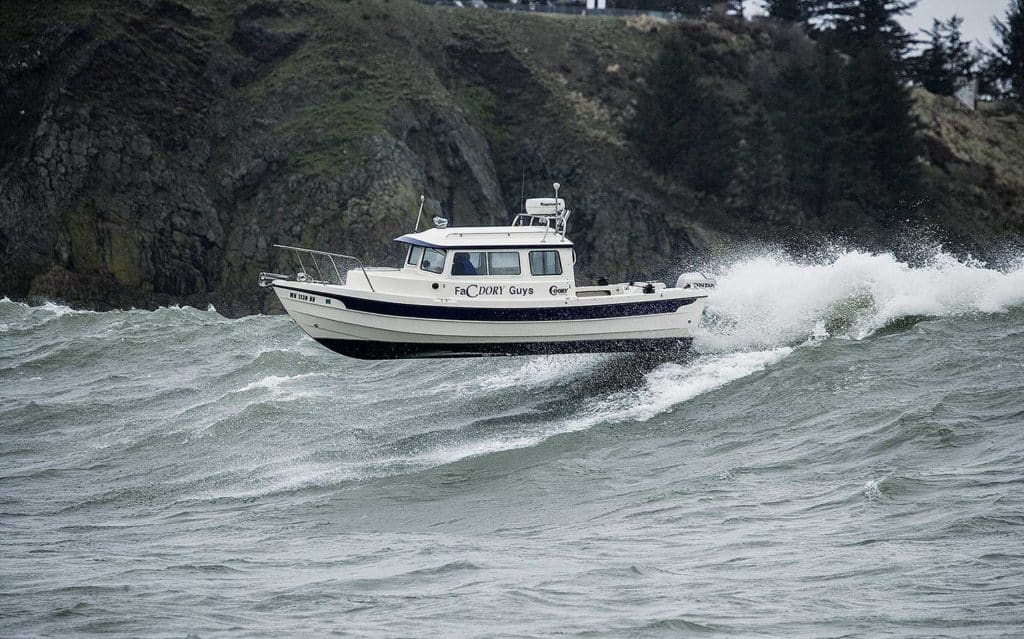
Study the Conditions
“A strong outgoing tide is always cause for concern,” says Capt. Eric Davis of Vero Beach, Florida. Davis guides anglers aboard his Pathfinder 2500 powered by a Yamaha 350. He regularly runs in and out of Fort Pierce, Sebastian and St. Lucie (aka Stuart) inlets. “When the wind pushes waves against an out-flowing current, it can make things dangerous, especially when coming in,” Davis points out.
Take some time to assess the inlet before making your run. Study the cycle of waves; there is often a rhythm to them. Long-period swells, for instance, often roll through in sets, with a slight lull in between.
Obviously, you want to cross where the waves are smaller. For this reason, Davis often avoids the deepest water in the middle of the channel when there is a strong outgoing tide. “The middle of the channel is usually where the current is strongest,” he says. “Hang to the side, where the waves are often smaller and tend not to break as much, but also avoid any potentially dangerous shoals.”
This advice applies to smaller boats, such as Davis’ Pathfinder 2500 bay boat, which don’t draw a lot of water. Larger, deep-draft sport-fishers, by necessity, need to stay in the middle of the channel to avoid grounding. Bigger boats are also better at handling larger waves.
To find the smoothest line, Davis recommends running on the downwind side of the main channel when you’re outside the protection of the jetties, using the south side when the wind is out of north/northeast and the north side when the wind is from the south/southeast.
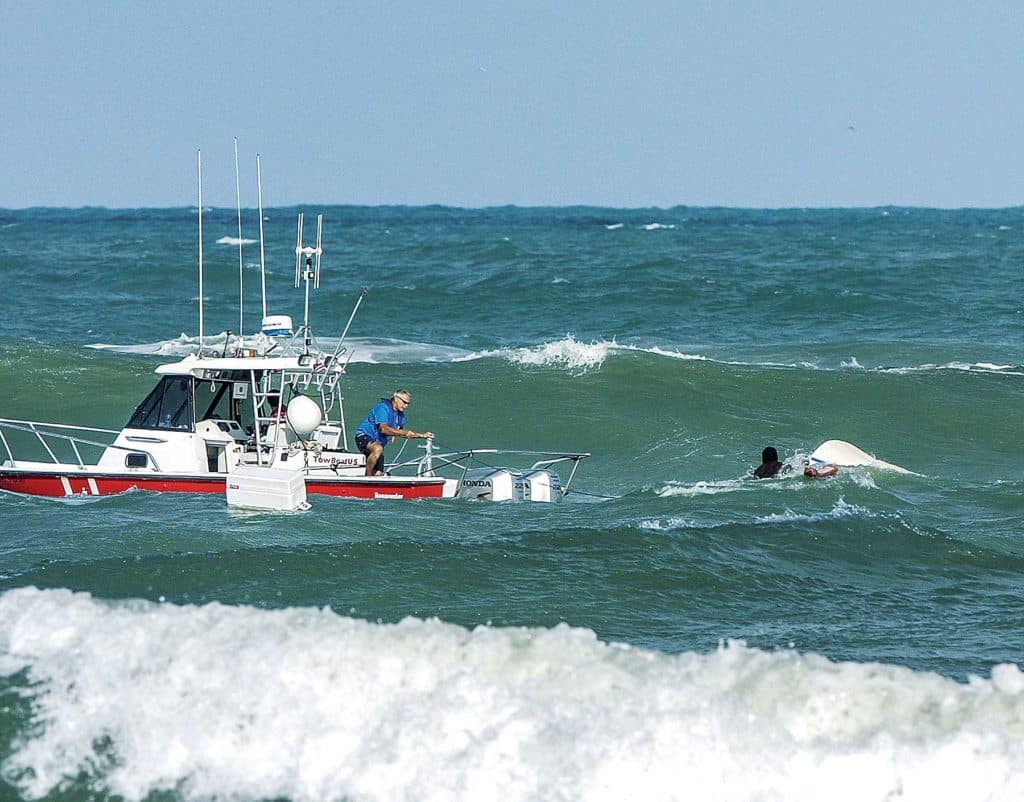
Wait It Out
Waiting a few hours for a slack tide can make the difference between a calm crossing and a calamitous one. “An incoming or slack tide tends to flatten out the waves in inlets such as Jupiter and Stuart,” Davis has discovered. This can mean cooling your heels for as long as five hours. If you’re coming back in the afternoon, that’s a long wait.
Another option is to run to another, more-user-friendly inlet. Though it will take time and you’ll burn more fuel, increased safety and peace of mind can make the extra miles worthwhile.
On days when the inlet is raging, let prudent seamanship prevail. “If it’s questionable, don’t go out,” Strum says. Your crew might be disappointed, but as the captain, it’s your job to make sure everyone stays safe.
Size and Power
The size of your boat counts. The last thing you want is a boat that’s too small to handle steep seas, Davis says. “You need to know the limitations of your boat ahead of time,” he adds. “You don’t want to be challenging steep 6- to 8-foot waves in a 20-footer.”
Having a high horsepower-to-weight ratio can also help keep you safe, Davis says. Power becomes especially important when trying to stay ahead of a breaking wave while returning. (See sidebar for tips on how to handle the boat in a rough inlet.)
Negotiating a rough inlet turns far more difficult when you can’t see clearly. Strum’s advice is to wait until daylight before you head out, and return before nightfall. If there’s heavy fog or torrential rain, wait until it clears before crossing the bar.
Low visibility also heightens the risk of collision with a jetty, breakwall, buoy or other vessels. More than one boat has run into a rock jetty while negotiating an inlet at night or in fog. If you must run an inlet in these conditions, use your radar and chart plotter to avoid collisions.
Inlets serve as gateways to many great fishing adventures. With these tips, a seaworthy vessel, sufficient power and a good measure of prudent seamanship, you will be able to meet the challenge of rough inlets, and cross over the bar to find fish and return safely time and again.
Precautionary Steps
When challenging a nasty inlet, make sure everyone dons a life jacket and knows to secure themselves for a run fraught with lumps, bumps and spray, Strum says. Brief everyone on what to do should catastrophe strike. Batten down any loose gear before making your run. Get all crewmembers on deck and, if possible, have them seated. They need to stay out of the cabin or other enclosure.
If you must remain in an enclosed space such as a pilothouse, wear an inflatable life jacket with a pull tab only — not one with an auto-inflation feature. This helps ensure your escape in the event of a capsizing. It is the same reason passenger-airline crews instruct you not to inflate your life jacket inside the plane. If water rushes into the cabin (be it airplane or boat), it will pin to the ceiling anyone wearing an inflated life jacket.
Ideally, all crewmembers should have a PLB (personal location beacon) attached to their life jackets. Also, be ready to deploy the EPIRB (Emergency Position Indicating Radio Beacon) quickly, especially if it requires manual activation.
Radio the U.S. Coast Guard or harbor patrol ahead of time if you are experiencing engine problems or other issues that might impair your ability to safely return. Authorities might choose to stand by to lend assistance in the event of an emergency.
Read Next: Ditch Bags: A Critical Element of Safe Boating
Running a Rough Inlet
Look for the safest line through the waves. Gaps in the froth indicate areas of relatively calm water. When heading out, maintain enough speed to keep the bow high. If you go too slow, the bow will drop and you will nose into the oncoming waves. If you go too fast, you’ll get beat up.
Head into the waves and do not slow down, even if you take water over the bow. Maintaining your speed forces any shipped water astern and out the scuppers. If you slow down, the water will surge forward and push the bow down, possibly resulting in a catastrophic swamping and rollover.
When returning, retract the trim tabs and maintain sufficient throttle to keep the boat running straight and in a position on the backside of a wave. Match the wave’s speed so the boat stays about midway between the face of the wave behind you and the crest of the one ahead.
By all means, avoid overtaking the wave ahead and surfing down its face. This can lead to catastrophic pitch-poling (flipping stern over bow). Also, don’t let a wave overtake you from astern because this can swamp your boat or cause it to broach (rolling over as the breaking wave catches the boat from behind and shoves it sideways) — or both. Stay in the trough.
Keep your eyes peeled and your head on a swivel in these situations to monitor waves behind and in front of you, as well as anything on either side. Some inlets are plagued by confused seas — so-called potato patches — that can buffet a boat from side to side, as well as fore and aft. If you see a wave suddenly break contrary to the pattern, try to dodge it or adjust your running angle to mitigate its impact.
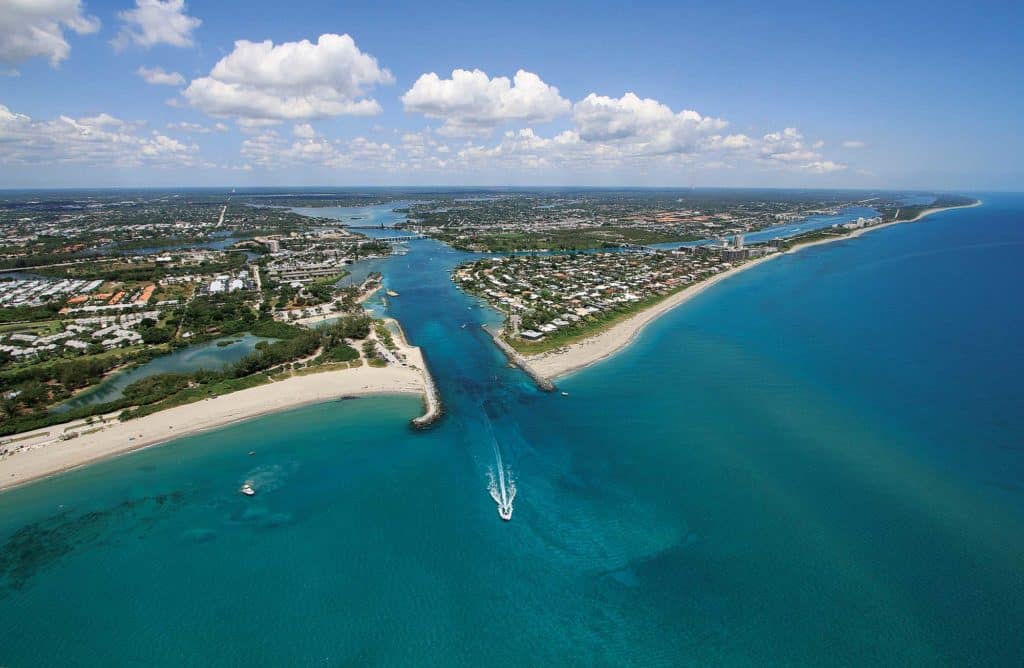
Treacherous Inlets
Here is a sample of U.S. inlets that often become decidedly dicey.
Sebastian, Florida
“Sebastian is one of the worst — not the one where you want to test your boating skills.”
—Capt. Eric Davis, Vero Backcountry Fishing
St. Lucie, Florida
“The St. Lucie Inlet has a reputation for being one of the most treacherous in Florida.”
—Florida Oceanographic Institute
Jupiter, Florida
“The most dangerous inlet in Palm Beach County.”
—Palm Beach Post
Boynton Beach, Florida
“You’d better have the right boat and know what you’re doing.”
—Capt. Chip Sheehan, Chips Ahoy Charters
Oregon Inlet, North Carolina
“I’m nervous every single time I run the inlet.”
—Brendan Strum, Manteo, North Carolina
Indian River, Delaware
“Indian River Inlet is extremely dangerous.”
—U.S. Coast Guard Station Indian River Facebook post
Moriches Bay, New York
“Strong currents can mix with brisk winds to create a melee of waves, eddies and exposed shoals.”
—marinas.com
Chatham, Massachusetts
“… the channel is narrow, and there are shifting sandbars that make it plenty hairy in an east wind.”
—Bob McNally, fishing writer
Columbia River Bar, Oregon/Washington border
This one is a doozy, “recognized as one of the most dangerous and challenging navigated stretches of water in the world.”
—columbiariverpilots.com
Nehalem Bay Bar, Oregon
All of Oregon’s inlets are dicey, but Nehalem is among the worst. “The entrance to Nehalem Bay at times becomes very rough and dangerous to cross.”
—oregonfishinginfo.com
Golden Gate, California
“The Golden Gate [at the entrance to San Francisco Bay] can be a very dangerous place for small boats due to the strong tides and large swells.”
—BoatUS




